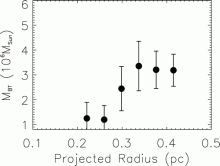
Abstract
We present results from K band slit scan observations of a ~20''x20'' region of the Galactic center (GC) in two separate epochs more than five years apart. The high resolution (R>=14,000) observations allow the most accurate radial velocity and acceleration measurements of the stars in the central parsec of the Galaxy. Detected stars can be divided into three groups based on the CO absorption band heads at ~2.2935 microns and the He I lines at ~2.0581 microns and ~2.112, 2.113 microns: cool, narrow-line hot and broad-line hot. The radial velocities of the cool, late-type stars have approximately a symmetrical distribution with its center at ~-7.8(+/-10.3) km/s and a standard deviation ~113.7(+/-10.3) km/s. Although our statistics are dominated by the brightest stars, we estimate a central black hole mass of 3.9(+/-1.1) million solar masses, consistent with current estimates from complete orbits of individual stars. Our surface density profile and the velocity dispersion of the late type stars support the existence of a low density region at the Galactic center suggested by earlier observations. Many hot, early-type stars show radial velocity changes higher than maximum values allowed by pure circular orbital motions around a central massive object, suggesting that the motions of these stars greatly deviate from circular orbital motions around the Galactic center. The correlation between the radial velocities of the early type He I stars and their declination offsets from Sagittarius A* suggests that a systematic rotation is present for the early-type population. No figure rotation around the Galactic center for the late type stars is supported by the new observations.